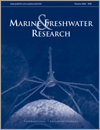Marine and Freshwater Research
Volume 69
Number 6 2018
Water quality conditions were measured in a semi-pristine catchment in the Far Northern Great Barrier Reef (GBR). Changes in water quality from upper catchment tributaries to GBR marine waters are assessed over three flood events. Data collected along the salinity gradient in this large northern catchment are compared to the more developed southern catchments.
We observed a dominant brown clionaid bioeroding sponge on south-eastern Indian coral reefs in 5-m water depth. Of all corals present and despite recent coral mortality, the encrusting Cliona sp. infested only live foliose Turbinaria mesenterina, of which ~50% colonies were affected. This infestation frequency is regarded as high, and the sponge should be fully taxonomically identified and monitored in the future.
We examined the effects of beaver impoundments on spatial and temporal variation in fish species composition and size structure. We placed our results in the context of the metacommunity theory. Although local communities changed over time, the main metacommunity characteristics remained constant. Fish must follow environmental changes for their populations and communities to persist in streams inhabited by beavers.
The present study investigated the use of non-lethal sampling of blood from horseshoe crabs to indicate the general status of coastal habitats. Changes in blood composition pattern of two Asian juvenile horseshoe crab species were found to be sensitive to reflect heavy metal and nutrient concentrations of intertidal sediments. Such a non-lethal sampling protocol can be useful for routine monitoring purposes.
We studied species composition, density, biomass and production of biting midges in two saline rivers (Volgograd region, Russia). They are a substantial seasonal food source for birds in this arid region. Average monthly production of biting midges during the study period in the saline rivers was much higher than annual production in some fresh rivers and lakes of world. For the first time, feeding spectra of one of the species of biting midges was studied using fatty acid analyses.
This paper explores coastal wetland response to sea-level rise. It reviews changing mangrove distribution over past millennia determined from cores in macrotidal estuaries of northern Australia. Mangroves retreated on the open coast, but were able to keep pace with gradual sea-level rise in adjacent estuaries. These insights imply that mangrove adjustment in future will vary as a function of local topography and sediment availability.
Low dissolved oxygen (hypoxia) in fresh waters is often a consequence of elevated dissolved nutrients, but only rarely are combined effects of nutrients and hypoxia on biota considered. In the at-risk freshwater crayfish Paranephrops zealandicus, hypoxia had several negative effects on respiratory and cardiac physiology and tissue biochemistry, but there was little additional effect of high ammonia or nitrite.
Environmental regimes set the timing and location of early life history events of migratory species with synchronised reproduction. This study assessed how the environment and spawners modulate recruitment variability and persistence of the Missouri River shovelnose sturgeon (Scaphirhynchus platorynchus) under modified seasonal habitat conditions. Model simulations illustrate that environmentally amplified maternal control of early life histories can lower sturgeon population stability and resilience under perturbations.
This study investigated the nutritional vulnerability of the larval stages of yellowline arrow crab (Stenorhynchus seticornis) to evaluate the physiological state of the larvae in their natural environment. Larvae were assigned to two experiments: (1) with increasing days of starvation and subsequent days of feeding; and (2) with increasing days of feeding and subsequent days of starvation.
Genetic diversity and structure of Pampus echinogaster were analysed using mitochondrial and nuclear DNA markers. High genetic homogeneity was found among Chinese populations of this species. The complex migratory ability and high dispersal of ichthyoplankton, as well as China’s offshore circulation, may play major roles in shaping the existing genetic structure of P. echinogaster.
Nest-building by fishes and its ecological role in reef ecosystems are poorly documented. We described the nest and nest-building behaviour of the endangered Brazilian basslet (Gramma brasiliensis). Males build complex bird-like nests using macroalgae thalli that camouflage nest entrance and form a cushion bed for egg laying. Nesting seems to be a critical aspect of the reproductive strategy of this species.
Low dissolved oxygen concentrations (hypoxia) can profoundly affect larval development in fish, but the effects of hypoxia on freshwater fish from tropical Australia are not well understood. In this study, the effects of daily fluctuations in hypoxia were investigated for embryos of a species that is common in wetlands of tropical Queensland. Eastern rainbowfish embryos appear to be tolerant to fluctuating hypoxia, possibly because eggs are laid predominantly on submerged plants.
Environmental (e)DNA is increasingly being used for biological assessment of aquatic ecosystems and although it is often touted as being more powerful, yet cheaper, than classical approaches to biomonitoring, empirical evidence is scarce. Herein we use a case study to contrast and compare classical and eDNA methods in terms of information generated balanced with costs and expertise.
Herbivorous fish biomass, sea urchin (Diadema savignyi) density, and algal and coral cover at 10 and 20 m was studied in the Easter Island ecoregion to identify patterns and relationships among these groups and the potential roles of herbivores, wave-energy exposure, and depth on these communities. Differences were found between islands and among levels of wave exposure. These patterns and the concordant patterns between herbivores and algae suggest herbivores and wave energy likely play important roles in structuring these benthic communities.




